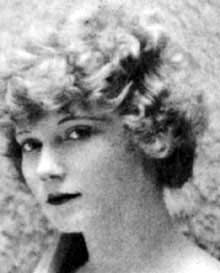Gilda Gray

Gilda Gray (October 24, 1901 - December 22, 1959) was a Polish born American actress and dancer who became famous in the US for popularizing a dance called the "shimmy" which became fashionable in 1920s films and theater productions.
Early life and 'The Shimmy'
Gilda Gray was born Marianna Winchalaska (or Michalska) in Kraków, Poland on 24 October 1901. Her birth parents were killed in a revolution and she was adopted from an orphanage. She escaped from Poland with her foster parents just before Krakow was taken over by Russia prior to World War I. Her parents emigrated to the United States in 1909 and settled in Milwaukee, Wisconsin. When Marianna was fourteen or fifteen, a marriage was arranged for her with a saloonkeeper's son, John Gorecki. To increase their income, Marianna began singing in saloons owned by her father-in-law.
Although the shimmy is said to have been introduced to American audiences by Gray in New York in 1919, other sources say that her shimmy was born one night when she was singing the Star Spangled Banner and forgot some of the lyrics. She covered up her embarrassment by shaking her shoulders and hips. Although the shimmy was already a well-known dance move, Marianna appropriated it as her own when she was asked about her dancing style, she replied in a heavy Polish accent; "I'm shaking my chemise," which sounded to the English-speaking audience like shimmy.
Move to America and show-biz
Her desire for to continue her burgeoning career and the faltering relationship with her husband prompted Gray to move to Chicago where she was noticed by a talent Frank Westphal who took her to New York and introduced her to his wife, singer Sophie Tucker. It was Tucker who prompted her to change her name to Gilda Gray.
By 1919, she was appearing in a J. J. Shubert show, The Gaieties of 1919. By 1920, Gilda had found a new manager, Gallaird T. 'Gil' Boag. After being seen by Florenz Ziegfeld, she appeared in the 1922 Ziegfeld Follies where she was enormously popular with the public. She began dating Boag during this time.
After her divorce from her first husband, in 1923 she married her new manager, Gil Boagand took her successful vaudeville to Hollywood, California. She quickly abandoned vaudeville to become a film star, and between 1919 and 1936 Gray made several movies, in all of which she performed her famous shimmy. Her second role was a small part in Girl with the Jazz Heart.
Jesse Lasky signed her to a contract with Famous Players. With him she made Aloma of the South Seas, which grossed $3,000,000 in its first three months. The success of this film was enhanced by Gilda's personal appearances doing the shimmy as a promotion. In 1927, she made two more films, The Devil Dancer and Cabaret.
'Crash' of '29, financial ruin
When the stock market crashed in 1929, Gilda Gray lost most of her financial assets, but she managed to get a job dancing at the Palace Theater in New York. In future years she attempted comebacks but was hindered by poor health from regaining her status as a star. By now her second marriage had failed due to the stresses of financial problems coupled with her habit of adultery.
In 1931 she suffered a heart attack. That same year she married a Venezuelan diplomat several years her junior, named Hector B. Riceno de Saa. This marriage also failed.
Litigation
In 1936 she was signed to play herself in the movie, The Great Ziegfeld, but unfortunately her scenes were cut from the picture. In 1949, she again became newsworthy when she sued Columbia Pictures for using her name in their movie, Gilda. Although the title role, played by Rita Hayworth, had no resemblance to the real Gilda's life, Gilda reportedly received an out of court settlement which enabled her to establish a ranch in Larkspur, Colorado. She dropped the suit in 1954 after asking for $1 million originally.
Polish patriot
In 1953 Ralph Edwards did her life story on his television show, This Is Your Life. He portrayed her courage in bringing six Polish citizens to America during the Cold War era. Miss Gray also subsidized their education. She was decorated by Poland for her interest and help to her countrymen and her country.
By the time of her death from a second heart attack on December 22, 1959, Gilda Gray was again in financial trouble. She died at 7922 Hollywood Boulevard at the age of 58. She had lived there with Mrs. Antonio Raio for the past six years. Gilda suffered an attack of food poisoning five days prior to her death and was under the treatment of a physician. The Motion Picture Relief Fund paid for her funeral. Pierce Brothers mortuary supervised her funeral proceedings.
Reference
- The Los Angeles Times, Shimmy Dancer Gilda Gray Dies, December 23, 1959, Page 2.
Filmography
- Virtuous Vamp (1919)
- Girl with the Jazz Heart (1923)
- Lawful Larceny (1925)
- Aloma of the South Seas (1927)
- Cabaret (1927)
- The Devil Dancer (1929)
- Piccadilly (1936)
- The Great Ziegfeld (1936)
- Rose-Marie (1936)
Plays
- Music Box Revue (1921)
- Ziegfeld Follies (1922)
- Devil Dancer Play (1927)
External links
- Gilda Gray at IMDb
- Gilda Gray at the Dance History Archives
